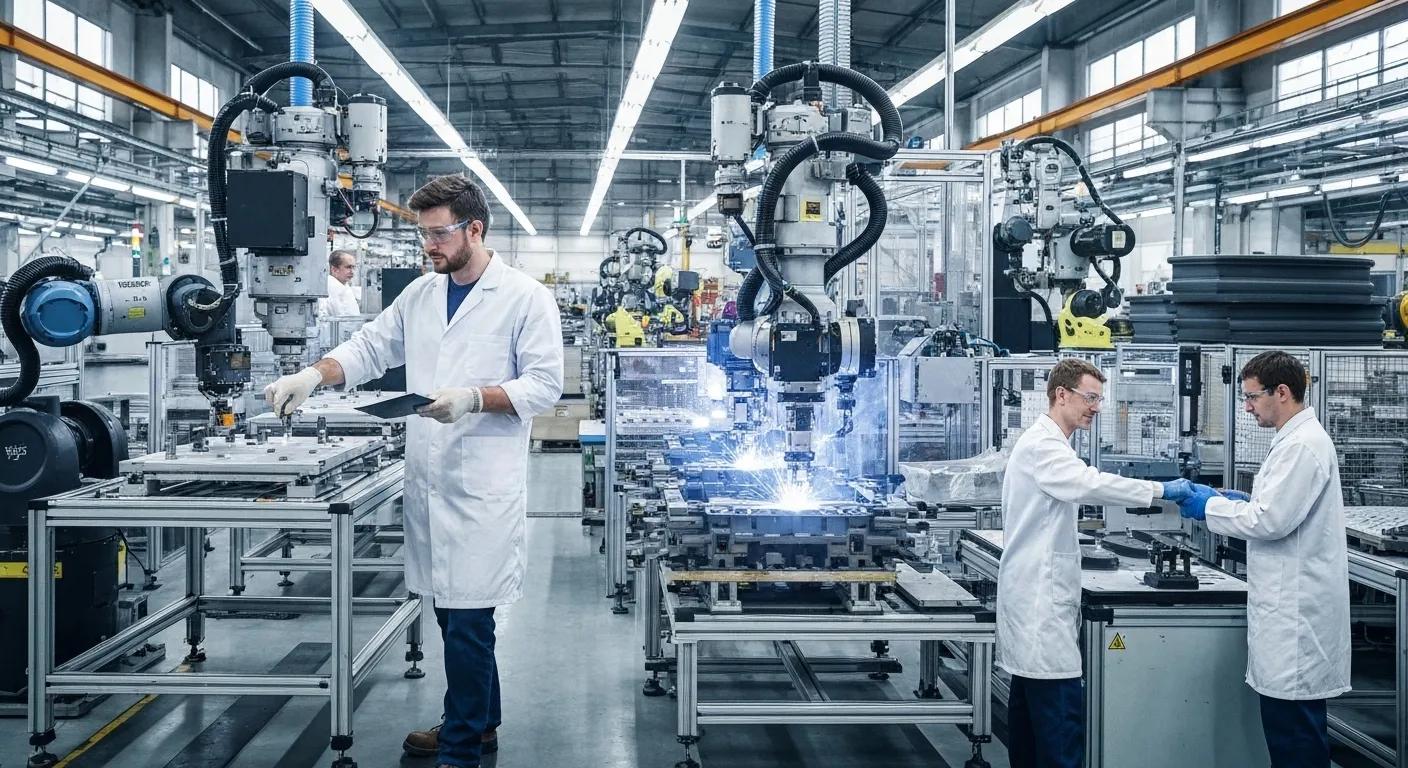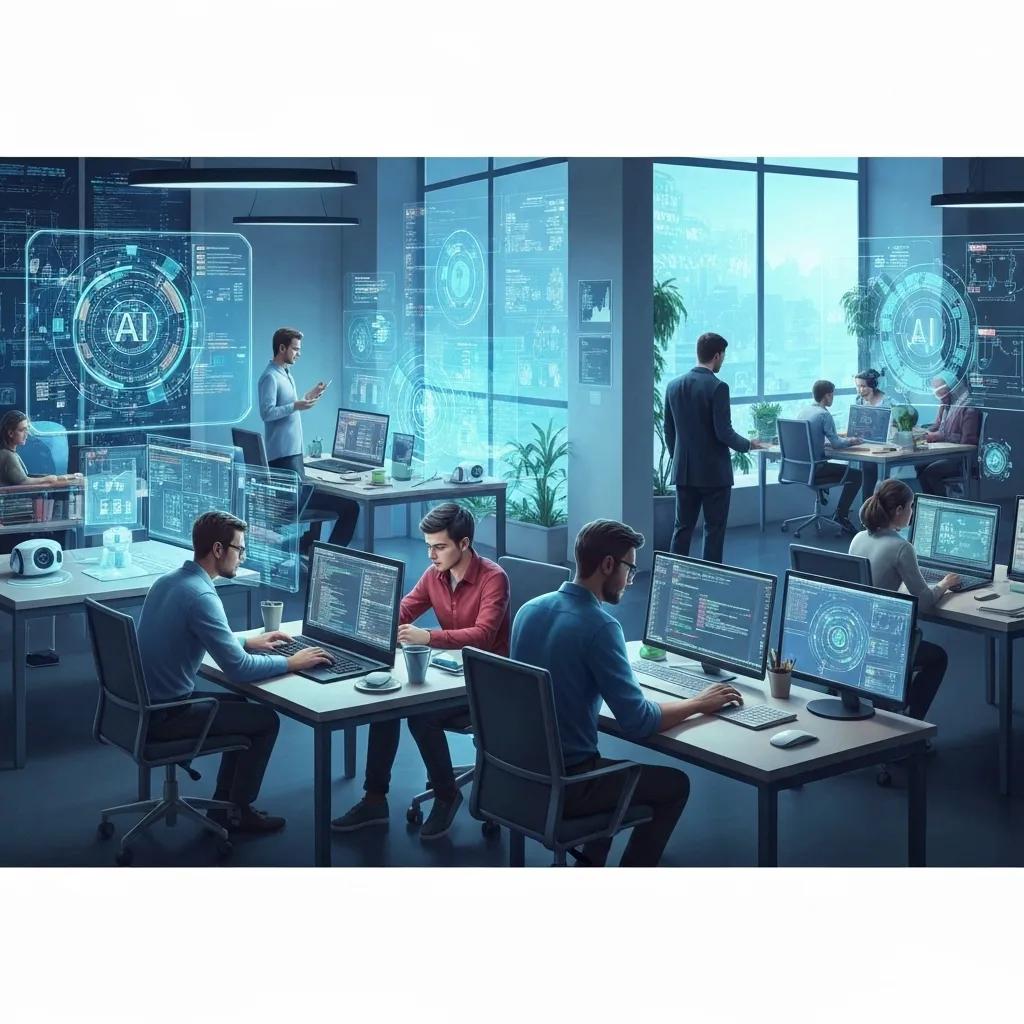
How Will Automation Reshape the Job Market? Exploring the Future Impact of Automation on Careers
Automation is set to transform the global workforce, phasing out routine positions while creating new opportunities in tech and people-focused fields, presenting both strategic hurdles and avenues for growth. In this guide, you’ll discover the future effects of automation on jobs, identify roles most at risk of displacement, explore emerging career paths, master strategies for upskilling, understand how AI-driven business automation boosts efficiency, and follow a practical plan for AI adoption. As businesses navigate concerns about job displacement and competitive pressures, we’ll show you how LeadSaver.ai’s AI Business Automation and AI Marketing Services equip companies to adapt, enhance team skills, and convert more leads through intelligent workflows. This comprehensive resource serves as your strategic guide to navigating an automated job landscape, balancing risk management with opportunity creation.
Which Jobs Face the Highest Risk from Automation and AI?

Jobs characterized by repetitive processes, predictable workflows, and high-volume data management are most susceptible to automation. Algorithms can often perform these tasks with greater efficiency and fewer errors, making these roles vulnerable to replacement. Understanding these vulnerabilities is crucial for organizations and individuals to plan for shifts in demand and necessary skill development.
Frey, C. B., & Osborne, M. A., The Future of Employment: How Susceptible Are Jobs to Computerisation? (2013)
What Types of Tasks Are Most Prone to Automation?
Tasks with clearly defined rules and minimal variability can be automated with high accuracy. Roles that involve performing these activities at scale are particularly affected.
| Task | Automation Level | Impact |
|---|---|---|
| Data Entry and Processing | Very High | Eliminates manual input errors |
| Invoice Generation | High | Accelerates billing cycles |
| Customer Inquiry Triage | High | Routes requests without human review |
| Inventory Reconciliation | Medium | Ensures stock accuracy automatically |
| Report Compilation | Medium | Synthesizes data in seconds |
Automating these tasks allows human effort to be redirected toward strategic and creative responsibilities, paving the way for significant sector-wide transformations.
Which Industries Are Experiencing the Most Profound Transformation?
The manufacturing, retail, and customer service sectors are rapidly adopting automation. AI systems are optimizing assembly lines, personalizing customer shopping experiences, and handling routine inquiries to reduce costs and enhance scalability. In manufacturing, collaborative robots (cobots) work alongside human employees to speed up the assembly of intricate components. Retailers are deploying machine learning-driven recommendation engines, and service providers are utilizing virtual assistants to address common customer queries. This industrial evolution highlights the critical need for workforce adaptation across both blue-collar and white-collar professions.
How Many Jobs Are Projected to Be Affected by Automation?
Projections for job displacement due to automation underscore the urgent need for skill realignment:
| Sector | Estimated Displacement (2025) | Context |
|---|---|---|
| Manufacturing | 20 million | Automated assembly and quality control |
| Transportation | 10 million | Self-driving vehicles and route optimization |
| Administrative | 15 million | AI-driven document processing |
| Retail | 10 million | Automated checkout and inventory management |
| Customer Service | 8 million | Chatbots and voice-response systems |
These figures emphasize the scale of impending workforce shifts, highlighting the necessity for proactive adaptation and reskilling initiatives across all industries.
What Are the Common Traits of Jobs Most at Risk?
Roles most vulnerable to automation share several key characteristics:
- Routine and Repetitive Tasks – Limited variability allows for highly accurate automation.
- Data-Intensive Processes – Large volumes of structured data are well-suited for algorithmic processing.
- Rule-Based Decision-Making – Clear policies and established workflows can be directly translated into code.
- Minimal Human Interaction – Tasks requiring little empathy or complex negotiation are prime candidates.
- Narrow Skill Requirements – Few specialized competencies simplify the deployment of automation.
Identifying these traits helps individuals and businesses focus reskilling efforts on roles with the highest displacement risk and pivot towards higher-value functions.
How Will Automation Generate New Job Opportunities and Roles?

Automation drives job creation by fostering demand for roles focused on developing, managing, and enhancing intelligent systems, ensuring businesses maximize the value derived from their AI investments. These emerging positions will redefine career trajectories and necessitate a blend of technical expertise and human-centric skills.
Manyika, J., Chui, M., Miremadi, M., Bughin, J., George, K., Willmott, T., & Henke, N., Jobs Lost, Jobs Gained: Workforce Transitions in a Time of Automation. (2017)
What New Careers Are Emerging in the AI and Automation Economy?
- AI Ethics Advisor: Establishes frameworks and governance for responsible AI implementation.
- Machine Learning Engineer: Designs the models that power automation and provide critical insights.
- Robotic Process Automation Developer: Creates automated bots to streamline enterprise workflows.
- Data Curator and Labeler: Prepares high-quality datasets essential for training AI systems.
- Human-AI Interaction Designer: Develops user experiences for collaborative intelligent systems.
How Does Automation Facilitate Job Evolution Rather Than Replacement?
Automation enhances human capabilities by taking over routine tasks, freeing employees to concentrate on creative, strategic, or interpersonal aspects of their roles, thereby boosting overall productivity. For instance, automated invoicing systems finalize billing processes in mere seconds, allowing finance professionals to dedicate more time to analyzing spending patterns and advising on cost-saving strategies. By delegating low-value tasks to machines, organizations encourage employees to cultivate higher-order skills that automation cannot replicate.
Which Soft and Technical Skills Will Drive Future Job Growth?
A combination of both soft and technical proficiencies will be vital for career resilience:
- Creativity and Innovation
- Critical Thinking and Problem-Solving
- Emotional Intelligence and Empathy
- Programming and System Design
- Data Literacy and Statistical Analysis
How Can the Workforce Adapt Through Reskilling and Upskilling?
Reskilling and upskilling initiatives equip employees with new competencies necessary to navigate the automated workplace, reducing the risk of job displacement and fostering continuous career advancement. Strategic learning programs are instrumental in transforming workforce capabilities and building organizational resilience.
Autor, D. H. Skills, Education, and the Rise of Earnings Inequality. (2015)
Why Is Reskilling Crucial in an Automated Job Market?
Reskilling aligns workforce capabilities with evolving job demands by offering targeted learning that bridges current skill gaps and leverages automation to amplify human contributions. Organizations that invest in employee training experience lower turnover rates, higher employee morale, and cultivate a culture of lifelong learning, positioning their teams to effectively adopt AI tools.
What Are the Most Effective Training Programs for AI Integration?
Here is a selection of leading programs designed to prepare professionals for AI-driven roles:
| Program | Focus Area | Outcome |
|---|---|---|
| Coursera “AI for Everyone” | Foundational AI Literacy | Improved decision-making across teams |
| edX “RPA Developer” | Robotic Process Automation | Hands-on automation deployment skills |
| Udacity “Machine Learning” | Model Development | Ability to build and evaluate ML models |
| Pluralsight “Data Analysis” | Data Manipulation | Enhanced data-driven insights generation |
Which Skills Are Essential for Success in the Future of Work?
Essential capabilities include:
- Digital Collaboration – Effectively working alongside AI systems and distributed teams.
- Adaptability and Learning Agility – Embracing continuous change and new methodologies.
- Leadership and Change Management – Guiding teams through periods of transformation.
How Can Businesses Support Employee Workforce Adaptation?
Organizations can foster adaptation by:
- Providing learning stipends and dedicated time for training.
- Collaborating with educational institutions to develop tailored curricula.
- Implementing robust mentorship and peer-learning programs.
- Designing human-AI workflows that synergize the strengths of both.
- Incentivizing skill acquisition through clear career progression pathways.
How Does AI Business Automation Enhance Efficiency and Productivity?
AI business automation streamlines decision-making, reduces manual workloads, and accelerates processes by utilizing algorithms to manage high-volume tasks, leading to cost savings and faster results. Companies that embrace these technologies achieve new levels of operational excellence.
What Are the Key Benefits of AI in Business Operations?
AI delivers significant advantages for enterprise workflows:
- Operational Efficiency – Automates repetitive tasks and shortens process cycle times.
- Error Reduction – Minimizes human errors in data handling and processing.
- Cost Optimization – Lowers labor expenses and improves overall accuracy.
- Faster Insights – Analyzes data in real time to support informed decision-making.
- Scalability – Expands operational capacity without a proportional increase in headcount.
These benefits establish a strong foundation for digital transformation and competitive differentiation.
How Do AI Marketing Services Improve Lead Conversion?
AI marketing services analyze customer data in real time to deliver personalized outreach, optimize campaign performance, and identify high-potential leads, potentially increasing conversion rates by up to 30%. LeadSaver.ai’s AI-driven marketing platform employs predictive analytics for automated lead scoring, personalized follow-ups, and streamlined campaign management, empowering sales teams to close deals more efficiently without relying on manual guesswork.
How Can Automated Workflows Provide a Competitive Edge?
Automated workflows help businesses stand out by enabling them to:
- Shorten turnaround times for customer requests.
- Ensure consistent adherence to regulatory compliance.
- Elevate customer experiences through prompt responses.
- Reallocate human resources towards innovation and strategic initiatives.
These operational improvements allow companies to adapt quickly to market changes and outperform competitors.
What Strategic Steps Should Business Owners Take to Implement AI Automation?
Business owners should follow a structured AI roadmap that includes needs assessment, pilot testing, and scaling phases to ensure seamless integration and measurable business impact. A well-defined strategy transforms AI from a mere buzzword into a tangible growth catalyst.
How Do You Develop an Effective AI Adoption Roadmap?
Effective AI adoption involves the following steps:
- Assess Current Processes – Identify manual, time-consuming tasks ripe for automation.
- Define Objectives – Establish clear performance metrics and ROI targets.
- Select Appropriate Tools – Evaluate solutions based on suitability and scalability.
- Pilot Implementation – Test on a small scale to validate effectiveness and outcomes.
- Measure Performance – Track key performance indicators such as time saved and error reduction rates.
- Scale Across Operations – Expand successful pilot programs to broader workflows.
By adhering to this structured methodology, organizations can minimize risks and accelerate the realization of AI-driven value.
How Can Businesses Measure the ROI of AI Automation?
Measuring ROI involves tracking key performance indicators such as time saved, cost reductions, improvements in lead conversion rates, and overall revenue growth to quantify the financial benefits of AI automation investments. Monitoring these KPIs facilitates data-driven decisions regarding further automation initiatives and continuous improvement efforts.
What Are Best Practices for Managing Human-AI Collaboration?
Optimizing collaboration between people and AI requires:
- Clarifying Roles – Clearly define responsibilities for humans versus AI systems.
- Maintaining Transparency – Ensure AI decisions are explained to relevant stakeholders.
- Offering Continuous Training – Keep teams updated on evolving AI capabilities.
- Fostering Feedback Loops – Capture human insights to refine AI algorithms.
- Establishing Governance – Implement clear policies for responsible AI utilization.
These practices foster a harmonious partnership that maximizes workforce potential.
What Are the Industry-Specific Impacts of Automation on Service and Sales Sectors?
The service and sales industries face distinct automation dynamics as AI tools handle repetitive tasks and enhance customer interactions, reshaping both back-office operations and frontline roles. Tailored strategies are essential for these sectors to maximize value from automation.
How Is Automation Changing Jobs in the Service Industry?
Service roles are evolving through:
- Automated Scheduling – Self-service booking platforms reduce administrative burdens.
- Self-Service Portals – AI-powered knowledge bases enable customers to resolve issues independently.
- Predictive Maintenance Alerts – Sensors and AI predict potential equipment failures.
- Virtual Assistants for Bookings – AI chatbots manage reservation tasks efficiently.
By automating these functions, service businesses can deliver faster, more reliable customer experiences while allowing staff to focus on oversight and relationship building.
How Can Sales Teams Leverage AI Tools for Lead Conversion?
Sales teams can utilize AI-powered lead scoring, chatbots for initial customer engagement, and automated follow-up sequences to prioritize high-potential prospects and optimize outreach strategies. LeadSaver.ai’s platform provides real-time lead insights and personalized messaging, enabling sales representatives to focus on closing deals rather than manual data management.
What Case Studies Demonstrate Successful AI Adoption in These Sectors?
Examples of effective AI implementation include:
- ServicePro reduced manual scheduling tasks by 50% using AI workflow tools.
- RetailCo boosted sales by 20% through the implementation of predictive lead scoring.
- DevTeam decreased response times by 60% by deploying automated chatbots.
These case studies highlight how targeted automation drives tangible operational and financial benefits.
How Will Future Job Landscapes Balance Automation Risks and Opportunities?
Future job landscapes will achieve balance by integrating advanced AI capabilities with human ingenuity, fostering roles that demand complex problem-solving and emotional intelligence while automating routine work. This equilibrium supports sustainable growth and continuous innovation.
What Are the Long-Term Trends in Automation and Employment?
Anticipated trends include:
- Hybrid Human-AI Teams – Collaborative work models designed to enhance productivity.
- Rise of Micro-Entrepreneurship – AI-powered gig platforms facilitating flexible ventures.
- Platform-Based Work Models – Digital marketplaces efficiently matching clients with specialized skills.
- Continuous Learning Ecosystems – Ongoing training integrated seamlessly into daily workflows.
These trends illustrate the co-evolution of technology and human talent in response to market demands.
How Can Businesses Turn Automation Challenges into Growth Opportunities?
Organizations can transform automation-related challenges into growth opportunities by:
- Innovating Service Offerings – Developing AI-enhanced products and services.
- Reskilling the Workforce – Equipping employees with strategic and technical competencies.
- Building AI-Driven Products – Leveraging data insights to create new revenue streams.
- Forming Strategic Partnerships – Collaborating with technology providers to accelerate progress.
Proactive strategies enable businesses to thrive in an automated future rather than simply react to changes.
What Role Will Human Creativity and Emotional Intelligence Play?
Human creativity and emotional intelligence will be foundational to value creation in automated workplaces, driving innovation, nurturing customer relationships, and navigating complex ethical decisions that lie beyond algorithmic capabilities. As AI handles routine processes, uniquely human strengths will become the primary drivers of competitive advantage and organizational culture.
Automation will continue to reshape job landscapes, but by focusing on emerging roles, investing in reskilling, and adopting intelligent business automation—such as the solutions offered by LeadSaver.ai—companies can ensure sustainable growth and empower their workforce. Embrace the potential of automation, explore how LeadSaver.ai’s AI Business Automation and Marketing Services align with your strategy, and book a demo today to start redefining your competitive edge.

